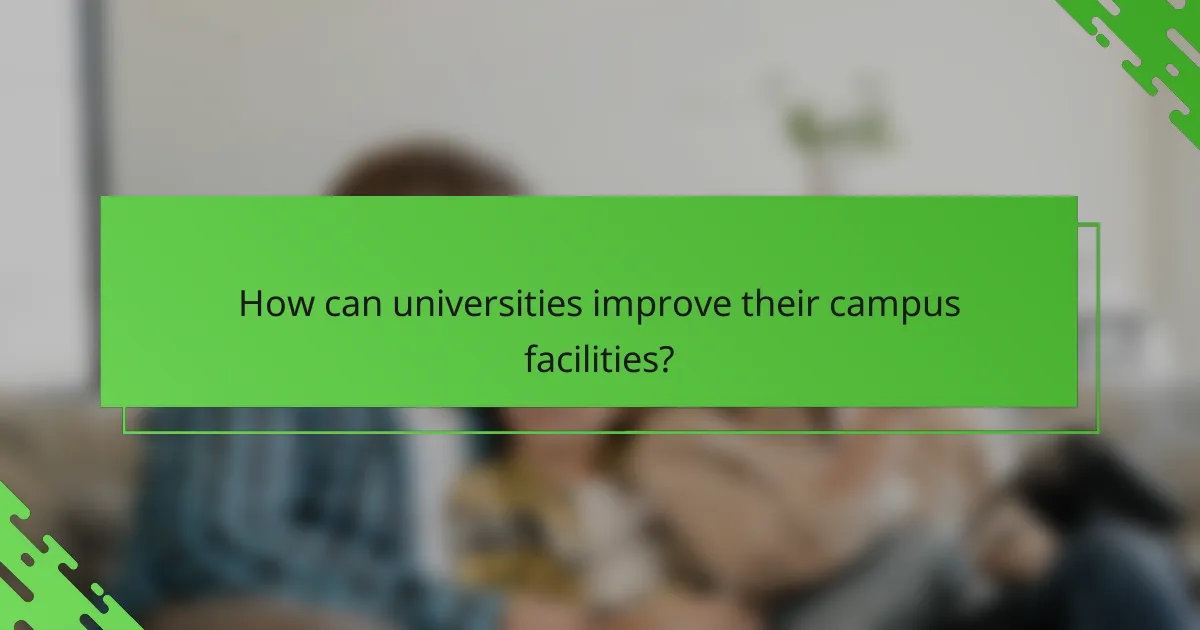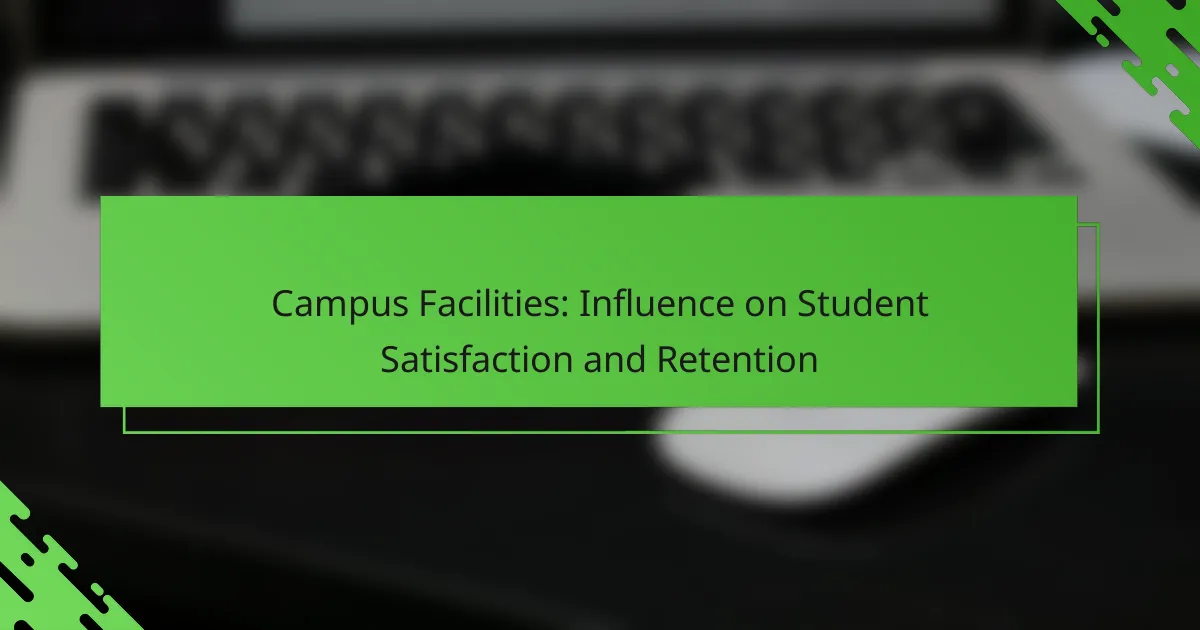Campus facilities play a crucial role in shaping student satisfaction and retention by offering vital resources and fostering a welcoming atmosphere for learning and social engagement. Modern amenities such as libraries, fitness centers, and study lounges not only enhance the educational experience but also encourage students to remain connected and committed to their academic journeys.

How do campus facilities impact student satisfaction?
Campus facilities significantly influence student satisfaction by providing essential resources and creating an environment conducive to learning and social interaction. Well-maintained amenities, accessible resources, and inviting social spaces contribute to a positive campus experience, which can enhance student retention rates.
Quality of amenities
The quality of amenities, such as libraries, laboratories, and recreational centers, directly affects student satisfaction. High-quality facilities can enhance learning outcomes and provide students with the tools they need to succeed academically. For instance, modern computer labs equipped with up-to-date technology can facilitate better research and project work.
When evaluating amenities, consider factors like cleanliness, maintenance, and availability. Institutions should aim to keep facilities in excellent condition, as deteriorating amenities can lead to frustration and decreased satisfaction among students.
Accessibility of resources
Accessibility of resources, including academic support services and study spaces, plays a crucial role in student satisfaction. Resources should be easy to reach, with extended hours to accommodate diverse schedules. For example, libraries that are open late and offer quiet study areas can significantly enhance the student experience.
Additionally, ensuring that resources are inclusive and cater to all students, including those with disabilities, is vital. Institutions should regularly assess accessibility and make necessary adjustments to meet the needs of their diverse student body.
Social spaces availability
The availability of social spaces, such as lounges, cafes, and outdoor areas, fosters community and enhances student satisfaction. These spaces provide opportunities for students to relax, socialize, and collaborate on projects, which can strengthen their sense of belonging on campus.
To optimize social spaces, institutions should consider their design and location. Comfortable seating, Wi-Fi access, and proximity to academic buildings can encourage students to utilize these areas more frequently, ultimately contributing to a more vibrant campus life.

What facilities enhance student retention rates?
Facilities that significantly enhance student retention rates include modern libraries, fitness centers, and study lounges. These amenities contribute to a supportive learning environment, encouraging students to remain engaged and satisfied with their campus experience.
Modern libraries
Modern libraries serve as vital resources for student retention by providing access to extensive collections, study spaces, and technology. They often feature collaborative areas, quiet zones, and media resources that cater to diverse learning styles.
To maximize the benefits of a library, institutions should ensure that it is equipped with up-to-date technology, comfortable seating, and ample study materials. Regular workshops and events can also foster a sense of community and encourage students to utilize these spaces more frequently.
Fitness centers
Fitness centers play a crucial role in promoting student well-being, which is closely linked to retention. Access to exercise facilities helps students manage stress, improve mental health, and maintain physical fitness.
Colleges should consider offering a variety of fitness classes, personal training options, and recreational sports to engage students. Creating a welcoming atmosphere and encouraging social interaction can further enhance the appeal of fitness centers, making them a hub for student life.
Study lounges
Study lounges provide essential spaces for students to collaborate, focus, and unwind. These areas should be designed to accommodate both individual study and group work, offering a mix of seating options and resources.
Institutions can enhance study lounges by incorporating comfortable furniture, charging stations, and access to whiteboards or technology. Regularly hosting study sessions or tutoring programs can also encourage students to utilize these spaces effectively, fostering a sense of belonging and academic support.

Which universities excel in campus facilities?
Several universities are recognized for their outstanding campus facilities, which significantly enhance student satisfaction and retention. Institutions like the University of California, Berkeley, the University of Michigan, and Florida State University stand out for their comprehensive amenities and supportive environments.
University of California, Berkeley
The University of California, Berkeley, is renowned for its state-of-the-art facilities, including modern libraries, research centers, and recreational spaces. These amenities foster a vibrant campus life, encouraging students to engage academically and socially.
Berkeley’s commitment to sustainability is evident in its green buildings and energy-efficient designs, which not only enhance the campus experience but also align with students’ values regarding environmental responsibility. The campus offers numerous study spaces, dining options, and wellness facilities that cater to diverse student needs.
University of Michigan
The University of Michigan boasts extensive facilities that support both academic and extracurricular activities. Its libraries are among the largest in the nation, providing students with vast resources for research and study.
In addition to academic spaces, the university features impressive athletic facilities, including the iconic Michigan Stadium. These facilities contribute to a strong school spirit and community engagement, which are vital for student retention and satisfaction.
Florida State University
Florida State University (FSU) excels in providing a well-rounded campus experience through its modern facilities. The campus includes a variety of recreational centers, libraries, and study lounges that cater to student preferences.
FSU emphasizes student wellness with its health services and fitness programs, which are crucial for maintaining a balanced lifestyle. The university’s commitment to enhancing campus facilities helps create an inclusive environment, fostering a sense of belonging among students.

What criteria should be considered when evaluating campus facilities?
When evaluating campus facilities, key criteria include facility condition, student feedback, and usage statistics. These factors collectively influence student satisfaction and retention, providing insights into how well the facilities meet the needs of the student body.
Facility condition
The condition of campus facilities directly impacts student experiences. Well-maintained buildings, classrooms, and recreational areas contribute to a positive learning environment. Regular assessments should be conducted to identify maintenance needs and ensure compliance with safety standards.
Consider factors such as cleanliness, accessibility, and modern amenities. Facilities that are outdated or in disrepair can deter student engagement and satisfaction. Investing in renovations or upgrades can significantly enhance the overall campus experience.
Student feedback
Gathering student feedback is crucial for understanding their perceptions of campus facilities. Surveys, focus groups, and suggestion boxes can provide valuable insights into what students appreciate and what areas need improvement. Actively seeking and responding to feedback fosters a sense of community and involvement.
It’s important to analyze feedback trends over time. For example, if multiple students express concerns about a specific facility, it may indicate a need for immediate attention. Engaging students in discussions about facility improvements can lead to higher satisfaction and retention rates.
Usage statistics
Usage statistics offer quantitative data on how often and effectively campus facilities are utilized. Tracking attendance in libraries, gyms, and study spaces can reveal which facilities are most popular and which may require enhancements or reconfiguration.
Consider establishing benchmarks for facility usage. For instance, a library that sees low foot traffic may need to reassess its resources or programming. Regularly reviewing these statistics helps ensure that facilities align with student needs and preferences, ultimately supporting retention efforts.

How can universities improve their campus facilities?
Universities can enhance their campus facilities by prioritizing student feedback, allocating funds for upgrades, and integrating modern technology. These strategies can significantly boost student satisfaction and retention rates.
Conducting surveys
Conducting surveys is a vital step for universities to understand student needs and preferences regarding campus facilities. Regular feedback can reveal areas requiring improvement, such as study spaces, recreational areas, or dining options.
Surveys should be designed to gather both quantitative and qualitative data. For instance, using a mix of rating scales and open-ended questions can provide a comprehensive view of student satisfaction.
Investing in renovations
Investing in renovations can dramatically enhance the campus experience. Universities should focus on updating older buildings and creating inviting spaces that foster collaboration and learning.
Renovation projects can vary widely in cost, typically ranging from thousands to millions of dollars depending on the scope. Prioritizing high-traffic areas, such as libraries and student centers, can yield the best returns in student satisfaction.
Enhancing technology access
Enhancing technology access is crucial for modern educational environments. Universities should ensure that students have reliable internet access and up-to-date equipment in study areas and classrooms.
Implementing initiatives like free Wi-Fi across campus and providing loaner laptops can significantly improve the learning experience. Additionally, investing in smart classrooms equipped with the latest technology can facilitate better teaching and learning outcomes.

What are the emerging trends in campus facilities?
Emerging trends in campus facilities focus on sustainability, technology integration, and student-centered design. These trends aim to enhance the overall student experience, promoting satisfaction and retention through improved environments that cater to modern educational needs.
Sustainability in Campus Design
Sustainability is becoming a cornerstone of campus facility design, with institutions prioritizing eco-friendly materials and energy-efficient systems. Features like green roofs, solar panels, and rainwater harvesting systems are increasingly common, reducing the carbon footprint of campuses.
Colleges are also focusing on creating spaces that promote biodiversity, such as native plant gardens and wildlife habitats. These initiatives not only contribute to environmental goals but also enhance the aesthetic appeal of the campus, making it more inviting for students.
Technology Integration
Technology integration in campus facilities is transforming how students interact with their environment. Smart classrooms equipped with advanced audiovisual systems, interactive whiteboards, and high-speed internet facilitate enhanced learning experiences.
Additionally, mobile apps that provide real-time information about campus resources, such as study spaces or event schedules, are becoming standard. This tech-savvy approach helps students navigate their campus more effectively, contributing to higher satisfaction rates.
Student-Centered Spaces
Designing student-centered spaces is crucial for fostering community and engagement. Modern campuses are incorporating flexible study areas, collaborative workspaces, and comfortable lounges that cater to diverse student needs and preferences.
These spaces often include amenities like coffee shops and recreational areas, encouraging students to spend more time on campus. By creating environments that promote social interaction and collaboration, institutions can significantly enhance student retention and satisfaction.


